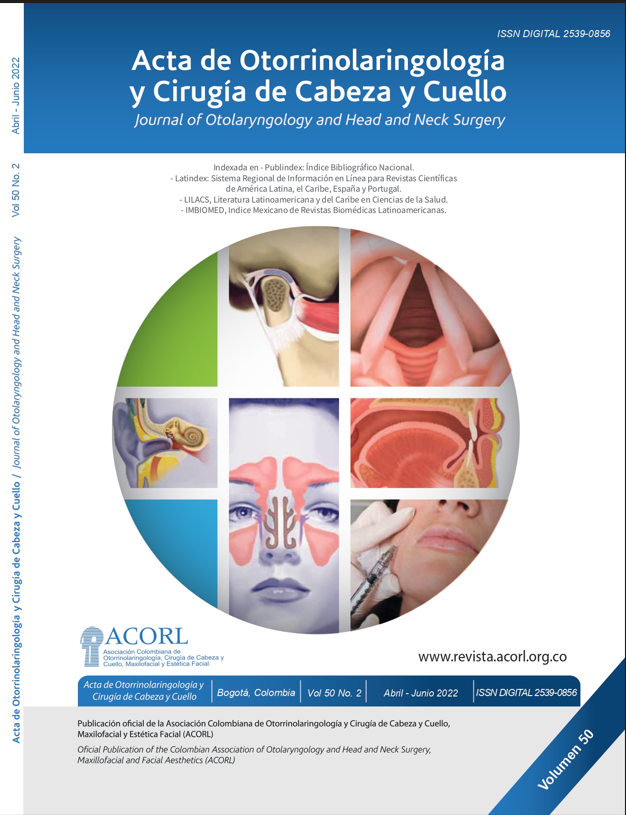Development of a Movil App for the Preoperative Evaluation of Sinus CT Scan: One Step Towards Artificial Intelligence
Main Article Content
Abstract
Introduction: The recent technology revolution that we have experienced has generated
extensive interest in the use of artificial intelligence (AI) in the development
of various systems and solutions in medicine. In the field of Otorhinolaryngology,
we are seeing the first efforts to take advantage of this flourishing area. Objective:
We sought to describe the development process of a mobile app created through a
collaborative effort between ENT surgeons and biomedical engineers. This app has
the intention to optimize the preoperative evaluation of paranasal sinus tomography
(CT) to improve safety and outcomes in Endoscopic Sinus Surgery (ESS). Methods:
The development of the app followed the prioritization method for MoSCoW specifications.
We used the information collected from surveys of 29 Rhinology experts
from different parts of the world, who evaluated anatomical variants on sinus CT
scans. Two regression models were used to predict difficulty and risk using statistical
learning. Conclusion: Via statistical modelling, we have developed a user-friendly
tool that will ideally help surgeons assess the risk and difficulty of ESS based on
the pre-operative CT scan of the sinuses. This is an exercise that demonstrates the
efficacy of the collaborative efforts between surgeons and engineers to leverage AI
tools and promote better solutions for our patients.
Downloads
Article Details

This work is licensed under a Creative Commons Attribution-ShareAlike 4.0 International License.
Este artículo es publicado por la Revista Acta de Otorrinolaringología & Cirugía de Cabeza y Cuello.
Este es un artículo de acceso abierto, distribuido bajo los términos de la LicenciaCreativeCommons Atribución-CompartirIgual 4.0 Internacional.( http://creativecommons.org/licenses/by-sa/4.0/), que permite el uso no comercial, distribución y reproducción en cualquier medio, siempre que la obra original sea debidamente citada.
eISSN: 2539-0856
ISSN: 0120-8411
References
Jotterand F, Bosco C. Artificial Intelligence in Medicine: A Sword of Damocles? J Med Syst. 2022;46(1):1-5. doi:
1007/s10916-021-01796-7
Crowson MG, Ranisau J, Eskander A, et al. A contemporary review of machine learning in otolaryngology–head and neck
surgery. Laryngoscope. 2020;130(1):45-51. doi: 10.1002/lary.27850
Dapre.presidencia.gov.co. Marco ético para la inteligencia artificial en Colombia [Internet]. Gobierno de Colombia. 2021
[citado falta la fecha]. Disponible en: https://dapre.presidencia. gov.co/TD/MARCO-ETICO-PARA-LA-INTELIGENCIAARTIFICIAL-EN-COLOMBIA-2021.pdf
Chowdhury NI, Smith TL, Chandra RK TJ. Automated classification of osteomeatal complex inflammation on CT
using convolutional neural networks. Int Forum Allergy Rhinol.2019;176(5):139-148. doi: 10.1002/alr.22196.
Liu GS, Bs AY, Ba DK, et al. Deep learning classification of inverted papilloma malignant transformation using 3D
convolutional neural networks and magnetic resonance imaging. 2022;(September 2021):1-9. doi: 10.1002/alr.22958
Spielman DB, Gudis DA. How I Do It Preoperative Sinus Computed Tomography Scan Review Checklist.
;(December):706-708. doi: 10.1002/lary.28444
Kagen S, Garland A. Asthma and Allergy Mobile Apps in 2018.Curr Allergy Asthma Rep. 2019;19(1):6. doi: 10.1007/s11882-019-0840-z
Dolin RH, Alschuler L, Boyer S, Beebe C, Behlen FM, Biron PV, et al. HL7 Clinical Document Architecture, Release 2. J
Am Med Inform Assoc. 2006;13(1):30-9. doi: 10.1197/jamia.M1888
Goossen W, Langford LH. Exchanging care records using HL7 V3 care provision messages. J Am Med Inform Assoc.
;21(e2):e363-8. doi: 10.1136/amiajnl-2013-002264
Dolin RH, Alschuler L, Beebe C, Biron PV, Boyer SL, Essin D, et al. The HL7 Clinical Document Architecture. J Am Med Inform Assoc. 2001;8(6):552-69. doi: 10.1136/jamia.2001.0080552
Haynes AB, Weiser TG, Berry WR, Lipsitz SR. A Surgical Safety Checklist to Reduce Morbidity and Mortality in a Global
Population. N Engl J Med. 2010;360(5):491-499. doi: 10.1056/NEJMsa0810119
Tewfik MA, Wormald PJ. Ten Pearls for Safe Endoscopic SinusSurgery. Otolaryngol Clin North Am. 2010;43(4):933-944. doi:10.1016/j.otc.2010.04.017
O’Brien WT, Hamelin S, Weitzel EK. The preoperative sinus CT: Avoiding a “cLOSE” call with surgical complications.
Radiology. 2016;281(1):10-21. doi: 10.1148/radiol.2016152230
García-Chabur MA, Peñaranda D, Pinzón M, et al. Lista de chequeo preoperatorio para la cirugía endoscópica de hipófisis Preoperative checklist for endoscopic pituitary surgery. Acta Otorrinolaringol Cirugía Cabeza y Cuello. 2020:322-330. doi:10.37076/acorlv48i4.562
Liquid-state.com. Digital Health App Trends to Consider for 2018 [Internet]. Digital Health Trends. 2018 [citado falta la
fecha]. Disponible en: https://liquid-state.com/digital-healthapp-trends-2018/

